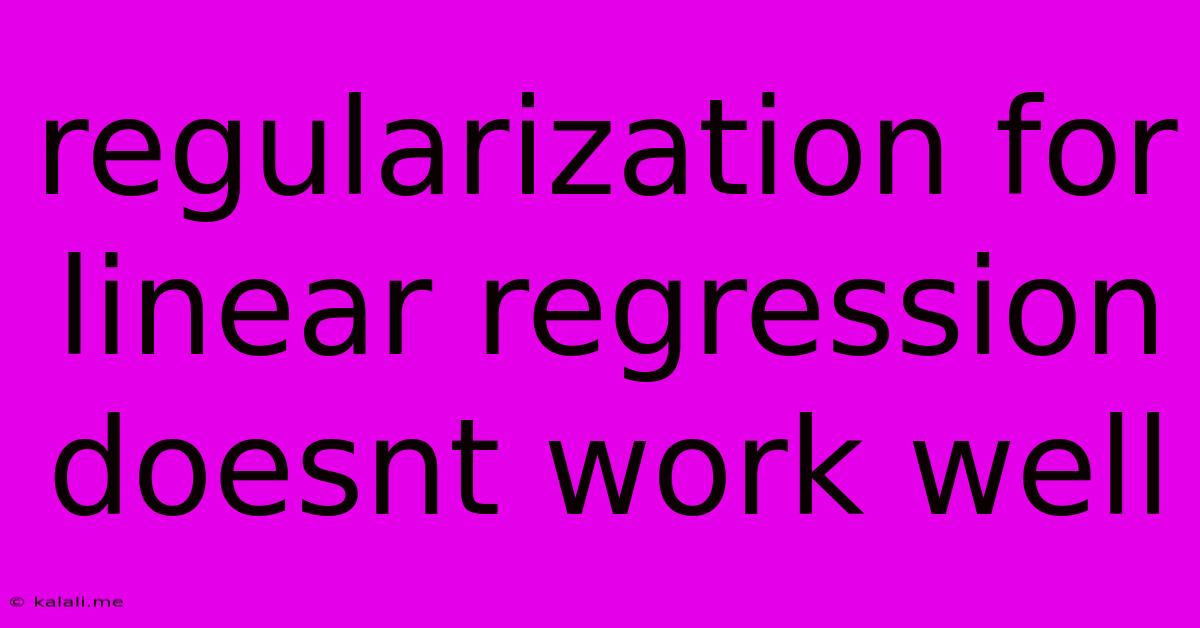Regularization For Linear Regression Doesnt Work Well
Kalali
May 24, 2025 · 3 min read

Table of Contents
When Regularization for Linear Regression Fails: Understanding the Limitations
Regularization techniques, like Ridge and Lasso regression, are powerful tools for preventing overfitting in linear regression models. They achieve this by adding a penalty term to the ordinary least squares (OLS) cost function, shrinking the magnitude of the coefficients. However, there are situations where regularization doesn't perform as expected, and even worsens the model's performance. This article explores these scenarios and offers insights into why regularization might fail and what alternative approaches could be considered.
Meta Description: Discover why regularization techniques in linear regression, like Ridge and Lasso, sometimes fail to improve model performance. We explore common causes and offer alternative strategies for handling overfitting.
Understanding the Core Problem: Overfitting and Underfitting
Before delving into the failures of regularization, it's crucial to understand the fundamental issues it aims to address: overfitting and underfitting.
-
Overfitting: Occurs when a model learns the training data too well, capturing noise and random fluctuations instead of the underlying patterns. This leads to excellent performance on the training set but poor generalization to unseen data.
-
Underfitting: Happens when a model is too simple to capture the complexity of the data, resulting in poor performance on both the training and testing sets.
Regularization aims to strike a balance, preventing overfitting by simplifying the model without causing underfitting. However, this balance is not always achievable.
Scenarios Where Regularization Might Not Work Well
Several factors can hinder the effectiveness of regularization in linear regression:
-
Irrelevant Features: If your dataset contains many irrelevant features (features that don't contribute to the prediction), regularization might not be sufficient to mitigate their impact. The penalty term may shrink the coefficients of relevant features alongside irrelevant ones, leading to a less accurate model. Feature selection or dimensionality reduction techniques may be more effective in this case.
-
High Multicollinearity: When predictor variables are highly correlated, it can inflate the variance of the regression coefficients, making them unstable. While regularization can help to some extent, it doesn't fully address the root cause. Techniques like Principal Component Analysis (PCA) are better suited for handling multicollinearity.
-
Incorrect Choice of Regularization Parameter (λ): The regularization parameter (λ) controls the strength of the penalty. Choosing an inappropriate value can lead to either overfitting (λ too small) or underfitting (λ too large). Careful tuning of λ through techniques like cross-validation is crucial for optimal performance. Poor hyperparameter tuning can easily lead to less-than-optimal model performance.
-
Non-linear Relationships: Linear regression assumes a linear relationship between the predictors and the response variable. If the true relationship is non-linear, regularization will not improve the model's accuracy, regardless of the λ value. Consider using non-linear models like Support Vector Machines (SVMs) or decision trees.
-
Insufficient Data: Regularization relies on having enough data to estimate the coefficients accurately. With limited data, the penalty term may unduly restrict the model's flexibility, leading to underfitting. Gathering more data or employing techniques like bootstrapping may be necessary.
-
Outliers: Outliers can significantly influence the regression coefficients. While regularization can reduce the impact of outliers to some degree, robust regression techniques may be more suitable for handling them effectively.
Alternative Approaches When Regularization Fails
If regularization is not providing the expected improvements, consider these alternatives:
-
Feature Selection: Carefully selecting the most relevant features can improve model performance and reduce the risk of overfitting.
-
Dimensionality Reduction: Techniques like PCA can reduce the number of variables while retaining most of the important information.
-
Robust Regression: Robust regression methods are less sensitive to outliers and can provide more reliable estimates.
-
Non-linear Models: Explore non-linear models if the underlying relationship between variables is non-linear.
Conclusion
Regularization is a valuable tool in the linear regression arsenal, but it's not a panacea for all overfitting problems. Understanding the limitations of regularization and exploring alternative approaches is crucial for building accurate and robust predictive models. Carefully consider the characteristics of your data and choose the appropriate technique to address the specific challenges you encounter. Remember that model selection is an iterative process; experimentation and evaluation are key to finding the best solution for your particular dataset.
Latest Posts
Latest Posts
-
How Many Days Is In 11 Weeks
Jul 14, 2025
-
How Many Grams Are In One Tola Gold
Jul 14, 2025
-
How Many Oz In A Pound Of Freon
Jul 14, 2025
-
How Many Years Are In A Millennia
Jul 14, 2025
-
Words With C As The Second Letter
Jul 14, 2025
Related Post
Thank you for visiting our website which covers about Regularization For Linear Regression Doesnt Work Well . We hope the information provided has been useful to you. Feel free to contact us if you have any questions or need further assistance. See you next time and don't miss to bookmark.